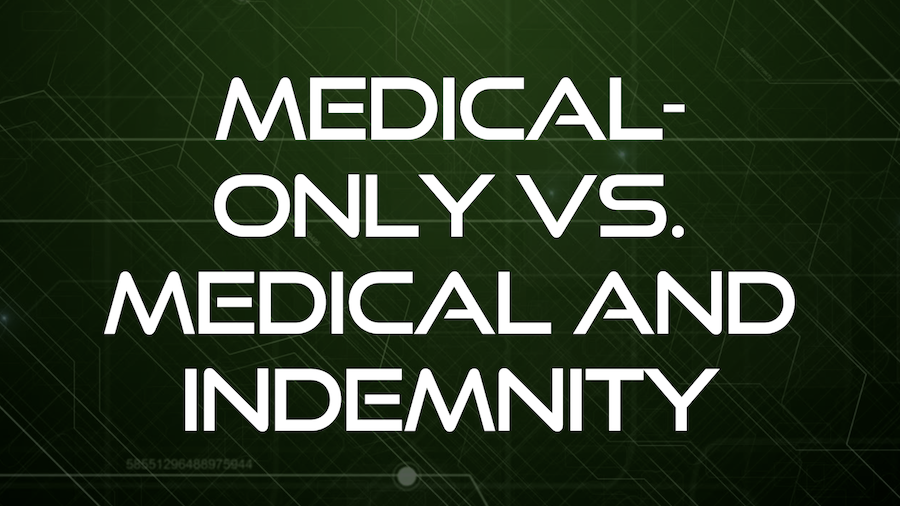Not all workers compensation claims are the same. It is important to understand that there may come a time when a workers’ compensation claim should be transitioned from a medical-only claim to a lost time or indemnity claim. Knowing when to do this will facilitate the claim handling process, will help to ensure it is properly handled using the correct resources, and help to save your company money.
Types of Claims
Most injury claims are medical-only claims. These are claims when employees do not miss work or are out of work only for a short period of time. Even though a worker might not miss time from work you shouldn’t underestimate these injuries by thinking they are minor or routine. Less serious workplace injuries can include minor burns, minor contusions, insect bites, an object in the eye, superficial abrasions or lacerations. You should monitor these injuries for any changes.
According to NCCI Medical only claims account for 78% of all claims, but only 6% of claims cost. Roughly 5% of all claims that are medical only will transition to a medical and indemnity claim.
For a claim to qualify for indemnity benefits the worker must be away from work more than three to seven days, depending on your state’s waiting period or end up with some damage to their body that results in a disability or impairment rating. Keep in mind that medical-only claims that become lost-time claims will cost your company a lot more than those claims that remain as medical-only.
It is interesting to note that the part of the body that is injured is a factor in the likelihood of that claim going from a medical-only to a lost-time claim.
What is the difference between a medical only claim and an indemnity claim?
A medical only claim takes place when the injured employee gets hurt, seeks medical attention, and is then released to return to work.
The indemnity claim will be a longer process. The worker’s injuries are typically more severe, will usually require more than just one doctor’s visit, and the worker may not be able to return to work right away due to the nature of their injury or injuries. An indemnity claim can go on for an extended length of time, and in some cases, can unfortunately become permanent. Typically these claims may involve surgeries or permanent damage to the injured worker.
In a Medical only claim, the employee is injured but the employee does not miss any time away from work. Medical only worker’s compensation claims are usually less costly than indemnity claims. This will help to keep your experience modifier or “ex-mod” and loss ratio low. In short, the ex-mod is a multiplier to your worker’s compensation policy premiums. When your ex-mod and loss ratios are higher, it can result in higher insurance premiums.
How to Pick the Best Option
So how do you decide the right option for a claim? You may not have a choice in some claims as the severity of the claim may dictate that it will be a medical and indemnity claim, but in smaller less severe claims you may be able to chose.
Here are some things that you should consider:
- How long will the employee be out of work? If it is just a few days, keeping the employee on payroll will typically provide a lower claim cost and positive impact on the work comp policy premium.
- Exactly what restrictions will the employee have and what kind of work will they be allowed to do?
- Do you have a position for this worker that will ensure they will not put their injury at risk?
- Can you pay the employee their full wages for reduced productivity and administrative work?
- Do you have a return to work program and will that help to get the employee back to work sooner than later?
Example
Let’s take a look at a real-life case so you can better understand the cost difference of a medical-only claim vs. a lost time claim and how your company can save money by carefully analyzing the injury case.
Miguel was working on a construction project. He bent down to pick up a heavy bag of cement to carry to the mixer. As he was lifting the load he felt a sharp shooting pain in his lower back. He immediately dropped the bag and had to sit down. He was in so much pain that he had difficulty standing up on his own. His supervisor immediately drove him to the local clinic where the physician performed a complete exam along with a CT scan. The scan revealed that Miguel had a herniated disc in his lower back (the lumbar region) and would have to be out of work for 4 to 6 weeks to rest and allow his back to properly recover.
Now you have to decide if it makes sense to keep Miguel on the payroll while he recovers (medical-only claim) or file it as a lost time claim and let your insurance company make the indemnity payments to Miguel.
Here are the facts:
- Your company is paying approximately $57,000 per year in workers’ compensation premium.
- Your current mod value is 0.77.
- The cost to pay Miguel for those 30 – 60 days is approximately $1,300 a week or between $5,200 to $10,400 over the course of his recovery.
- Your company’s current medical-only reserves are $11,300
In some states, in the experience mod calculation, medical-only claims have their loss value reduced by 70% whereas indemnity claims do not. Even though the mod value won’t change until 2024, the decision and actions you take today will affect that.
When the information is entered into a mod analysis software, like Mod Advisor, it is projected that the medical-only claim will increase your mod value from .79 to a .89.
If the claim is converted to a temporary indemnity claim, the value of the claim increases to $20,700 ($11,300 + $10,400) and the mod value increases to 1.04. So the difference in the mod value from a medical-only claim to a medical/indemnity claim is 15 points.
To calculate the premium impact, you can take the annual premium and multiply it by the increase in the mod value. This is $57,000 x .15 = $8,500. So, over 3 years the amount would be $25,650.
In Miguel’s case, it makes sense for your company to pay the continued wages directly to him. If your company spent $10,400 in wages they would save $15,250 in increased premium. By analyzing Miguel’s case you have saved your company money!

Common Claim Questions
How can you prevent a Medical-Only claim from becoming a Lost Time claim?
Here are some ways you can help to prevent cases from transitioning from medical-only to lost time:
- Send the injured workers to an approved medical provider.
It is common for injured employees to visit their family doctor after an incident. But not all family doctors will be familiar with or understand the importance of a return-to-work or light/modified duty program. As a result, they might restrict work entirely, not understanding that there are acceptable ways to get the injured employee back to work sooner. Whenever possible, send injured employees to pre-screened and approved doctors who know your return-to-work and modified duty program. - Treat all claims as potentially serious.
There could be times when minor injuries or illnesses become much more serious and are far more severe than you expected. Immediate and thorough medical attention is important for all injuries. Don’t underestimate an injury, because any injury can quickly turn into a lost-time claim if it is not handled properly. - Notify adjusters when you suspect fraud.
There may be times when an employee injury may seem suspicious. In this case, it’s important to let your adjuster know right away. The sooner an investigation can start, the sooner a fraudulent claim can be identified and stopped before it becomes a lost time claim. - Provide support to injured employees.
Employers who downplay their injuries or think they can go it alone can ultimately make their injury worse and take on lost-time claims. You should not discourage an employee from seeking medical treatment, even when the injury seems minor. When an injury doesn’t receive the right medical attention and recovery time, even minor injuries can become serious.
When does it make sense to transition the medical only claim to an indemnity claim?
In some cases, it is advantageous for a business to continue to pay wages to the employee. In other cases it makes sense to transition it to an indemnity claim. If and when you do this will help your company to save on workers compensation costs. You should consult your work comp professional for guidance. Software such as Mod Advisor can run the financial impact of claim scenarios so you decisions can be made using facts and estimated costs rather than just guessing.
Note: Occupational disease claims and repetitive or cumulative trauma claims should be handled as indemnity claims. Both usually begin with conservative treatment and no lost time, but it must confirm at the beginning that they are work related and an investigation will typically be required.
Not all claims handlers will understand the financial impact of paying $1 of indemnity and the impact that will have on an experience mod for the years that follow. Many times they are trying to meet internal deadlines and have a rather large workload. As a business you need to advocate for your desired outcome. When in doubt, it’s always best to communicate with your work comp professional.
What Should You Do Moving Forward?
Business Owners or HR – In situations where you are not sure, you should contact your agent to determine the best course of action. It is important for all stakeholders to keep the claim moving forward in the right direction. Companies that can correctly analyze and properly process these claims will benefit from lower workers comp premiums, get employees back to work sooner, and a positive claim experience for the injured employee. Ultimately, a properly handled claim will save your company money.
Agents – It is so important to educate your clients or prospects on how to handle claims. Make sure they are coming to you to guide them. As a marketing piece for prospects, use your experience and show them how you make the claims process smooth and can help save them money. Our software will give you documents to do just that and allow you to preform effective mod analysis. Reach out to us today at [email protected].

